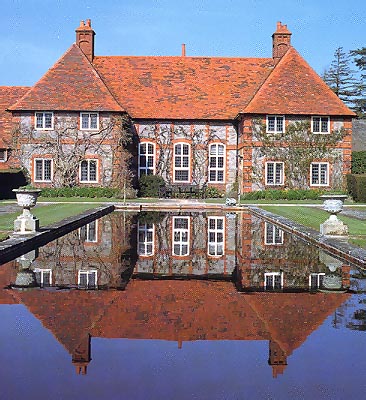
RBH Home
Maps & Travels
Articles
Legends
Towns & Villages
Castles & Houses
Churches
Biographies
Gentry
Family History
Odds & Ends
Mail David
 Folly
Farm
Folly
FarmSulhamstead Abbots, Berkshire
Folly Farm is Grade I listed and is an exceptional example of the continuation of classical and Arts and Craft architecture. It retains many impressive features. The ground floor has excellent entertaining space with well-proportioned reception rooms and plenty of bedrooms on the first floor. There is an attached staff flat and two cottages and a flat/office in the Mews Courtyard.
Folly Farm occupies a very special place in the list of over one hundred houses and gardens designed by Sir Edwin Lutyens with Gertrude Jekyll. The garden is one of the most complex of their designs and is regarded as one or the best examples or an English Twentieth Century garden.
Originally the main house comprised a timber-framed cottage which is believed to date back to around 1650 which was gradually enlarged into a farmhouse and now survives as the north-east wing of the present house. In 1906, Robert Venn sold Folly Farm to H. H. Cochrane who immediately commissioned Sir Edwin Lutyens RA to enlarge it for him. Lutyens, at that time, was one of the most fashionable country house architects and had a close relationship with Gertrude Jekyll who would give advice about the gardens for his houses as she did on Folly Farm. Lutyens added a symmetrical wing at right angles to the farmhouse in a seventeenth century William and Mary style in grey and red brick under a hipped roof. This closed the courtyard between the old farmhouse and the barn creating the original entrance court.
In 1912, Folly Farm was bought by Zachary Merton, a wealthy mine owner who again brought Lutyens back to add the west wing. Lutyens returned to his traditional Surrey style of Arts and Crafts architecture with red brick and clay tile hung elevations with a weather boarded gabled end. Along the Gallery, there is a Cloister which borders the pool and this wing has a subtly curved clay tile roof balanced with little dormer windows and a first floor sleeping balcony. The 1912, additions also included the circular dairy on the north-west corner, the Mews Courtyard and cottages. At the same time, the gardens were extended with the Dutch formal canal to the south of the William and Mary wing and the beautiful sunken rose garden.
Zachary Merton died in 1915 and his wife lent her home to the Lutyens family for the Summer of 1916. It was the first time Lutyens really lived in one of his own houses and Gertrude Jekyll even stayed at the house. Folly Farm was then sold after the First World War and during the Twenties and Thirties it was kept in a well-ordered splendour by the wine shipper and keen fisherman, Arthur Gilbey. Gilbey continued to add to the splendour of the gardens and they were written up extensively by Christopher Hussey in two Country Life articles in 1922. During the Thirties, the gardens were regularly opened in aid of the nurses charity. During the Second World War, the Gilbeys lent their house as a maternity hostel and, after the War, the house was sold to the Hon. Oliver Stanley MP, the younger son of the Earl of Derby.
The last owners purchased the property in 1951 and since then the house and garden have been the subject of many magazine articles and television programmes.
Folly Farm
is a private residence. Its gardens are very occasionally open to the
public. It was last offered for sale by FPD Savills in 2000.
